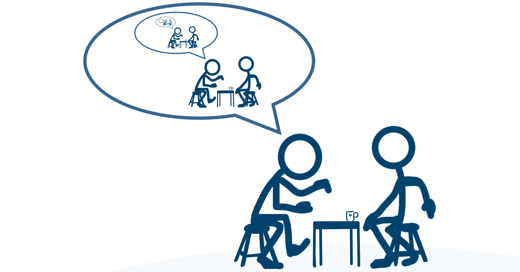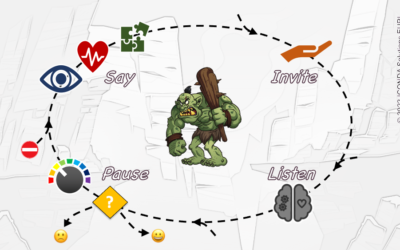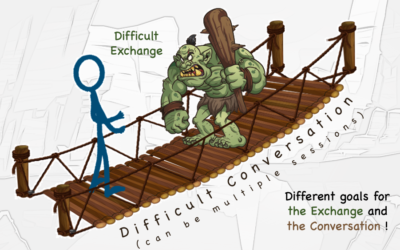Just as metadata means data about data, metacommunication is communication about communication[1]. When I complain about the media’s tendency to awfulize and terribilize, I am metacommunicating. Instead of explaining what I mean with long sentences and examples, I use a couple of simple, expressive words[2].
Metacommunication is important because communication is important. And just as you can’t get better at football if you don’t understand the abstract concepts of attack and defense, it’s impossible to improve communication skills without some capacity to talk about communication itself.
If you are a manager or team leader, encouraging and demonstrating metacommunication is a great way to develop the effectiveness of your team and to save you time.
How often do detail-oriented people infuriate their managers with the following types of meeting report?…
Manager: “How did it go Andy?”
Andy: “Great! Bernie kicked off with the slide on company structure, then we showed them the one on the product roadmap. Eric was really interested in this. He said, ‘blah, blah, …’”
And it’s even worse if Andy replies with just: “It was a great meeting!”
In the first case there was lots of data but little information – just a blow-by-blow account that left the manager to work out what was important. In the second (“It was a great meeting!”), no data and no information.
Something along the following lines would be so much more useful and easier to grasp: “Eric liked the roadmap slide: he’s keen to try v5 and learn about v6 but also spotted the discontinuities we tried to hide”
To metacommunicate effectively, professionals need to be able to describe conversations, meetings, writing, etc. at an appropriate level of abstraction.
We have a natural ability to do this – that’s why you understood what I meant by “awfulize” and “terribilize” in the first paragraph of this post. Shakespeare was also pretty good at describing communication with few words: “The empty vessel makes the loudest sound”, and “The lady doth protest too much”, for example.
Professionally speaking, those of us who don’t possess Shakespeare’s talent for brevity can develop our metacommunication abilities by exploiting the language of appropriate, domain-specific tools.
For example, if I were to describe a manager’s communication style as Directive, then you’d probably know what I meant. If I described it as Requestive, Emotive or Nurturative, then you may have some idea, but it would perhaps not be completely clear. In fact, these four terms are fully defined in the Process Communication Model (PCM) and people who share a knowledge of PCM are able to talk about communication for team management in a very efficient way.
Similarly, if several people are collaborating to produce a presentation – an important form of professional communication – then it helps if they share a common understanding and vocabulary to describe its overall structure. This allows them to plan their pitch at a high level of abstraction then divide the implementation work efficiently (such an approach is far more effective than starting with a draft slide deck then “refining” it, often ad infinitum).
For collaborative work to create presentations, I recommend the Two-Minute Message tool (TMM). This divides a presentation plan into four sections: Audience Context, Key, Supporting and Closing statements. Learning the tool comes down to understanding these four terms and integrating the rules associated with them. Just as for PCM, a major benefit of the TMM tool is that it facilitates metacommunication.
In a nutshell, metacommunication is essential for improving communication capability, both for individuals and teams. It helps us to stand back and observe our meetings, calls, emails, presentations, etc., thereby learning more from successes and failures. Communication tools – PCM, TMM and many others – provide language that facilitates metacommunication, and this is an important part of their added value.
I hope that I have beautifulized metacommunication adequately 🙂
The Process Communication Mode and the Two-Minute Message are just two of the tools that I use regularly in consulting and training work with customer-facing teams. You can find out more from this short video and these recent posts.
[1] The term ’metacommunication’ can also be used to describe a psychological message – the implicit, perhaps non-verbal, aspect of communication. In fact, a useful distinction can be made between metacommunication before, during and after the communication proper. I focus here on explicit metacommunication used after an event in order to clarify our observations.
[2] Thanks to Marica Powers for inventing « awfulize » and « terribilize » in her excellent book, The Dragon Slayer With a Heavy Heart.






